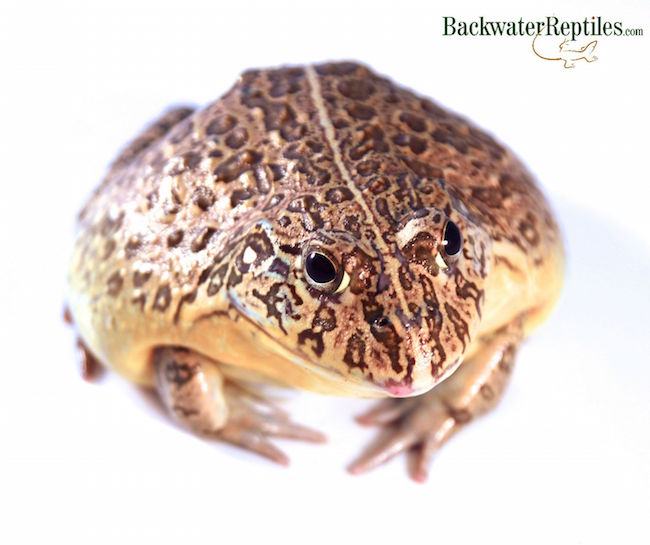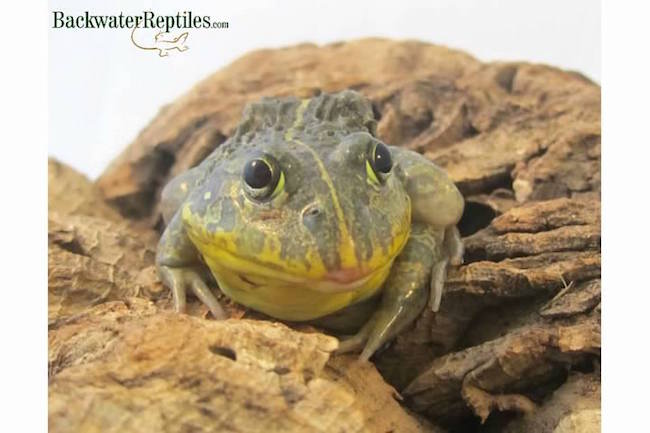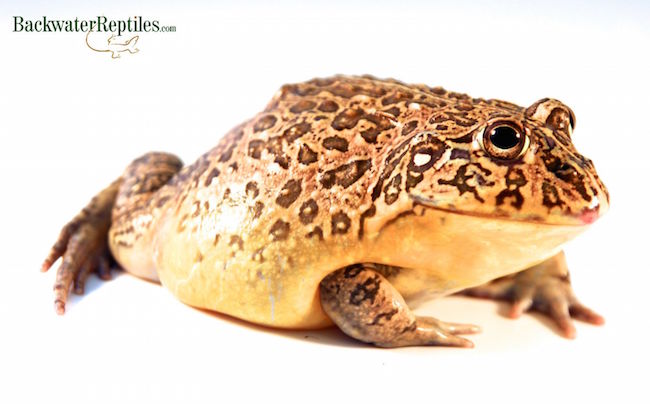Pixie frog care isn’t complicated or difficult. These frogs are known for their insatiable appetites, large size, and inclination to eat virtually anything small enough to fit in their mouth. Overall, they make for very entertaining and lively pet frogs, which is why they are so popular in the reptile hobbyist world.
Thinking of buying a pixie frog of your own? Then you’ll need to know how to care for one of these amphibious eating machines. Continue reading this blog article to find out how we care for ours at the Backwater Reptiles facility.
Pixie Frog Care (Pyxicephalus adspersus)
Pixie Frog Description
Known mainly for their massive size at maturity, pixie frogs are true giants. They are the second largest frog in the world and can reach lengths up to ten inches and weigh approximately two pounds! That might not seem like much, but it’s tremendous for a frog.
The largest frog in the world is the Goliath frog from Cameroon (Africa). It’s basically a huge frog that likes to jump–imagine a normal adult American Bullfrog, except 2-3 times larger.

Goliath frogs are actually illegal to export from Cameroon, and it’s just as well–they don’t fare well in captivity due to their habit of jumping several feet at a time. There just isn’t an enclosure large enough for them.

It should also be noted that pixie frogs are known by several common monikers. You might hear them referred to as African bull frogs, African burrowing frogs, and sometimes South African Pyxies.
Pixies are usually an olive green color at maturity, but they can also be shades of brown, yellow, and even creamy beige. They have very thick, stocky, hefty bodies and as adults, their bellies tend to protrude, which can give them a somewhat blob-like shape at rest. When they are babies, they tend to be a dark green shade with dark striped accents and cream-colored tummies.
Pixie Frog Habitat
Pixie frogs hail from Africa where they spend most of their time burrowed underground. This means that they will require a substrate that accommodates this behavior. Eco-earth, fertilizer-free, organic potting soil, and even paper towels are all acceptable options.You’ll want the substrate to stay moist and damp, but not wet.
A humid environment is best for pixies. We recommend keeping the enclosure at around eighty percent humidity for best results. Regular misting of the substrate will help keep the moisture level in the proper range. We use a spritzer bottle filled with water and squirt the substrate itself, the glass walls of the tank, and sometimes even the frogs themselves.
It’s also wise to invest in a sturdy water dish that is wide and shallow. You won’t see your pixie drink the water, but it helps maintain humidity levels and also allows your pixie to have itself a soak if it wants to.
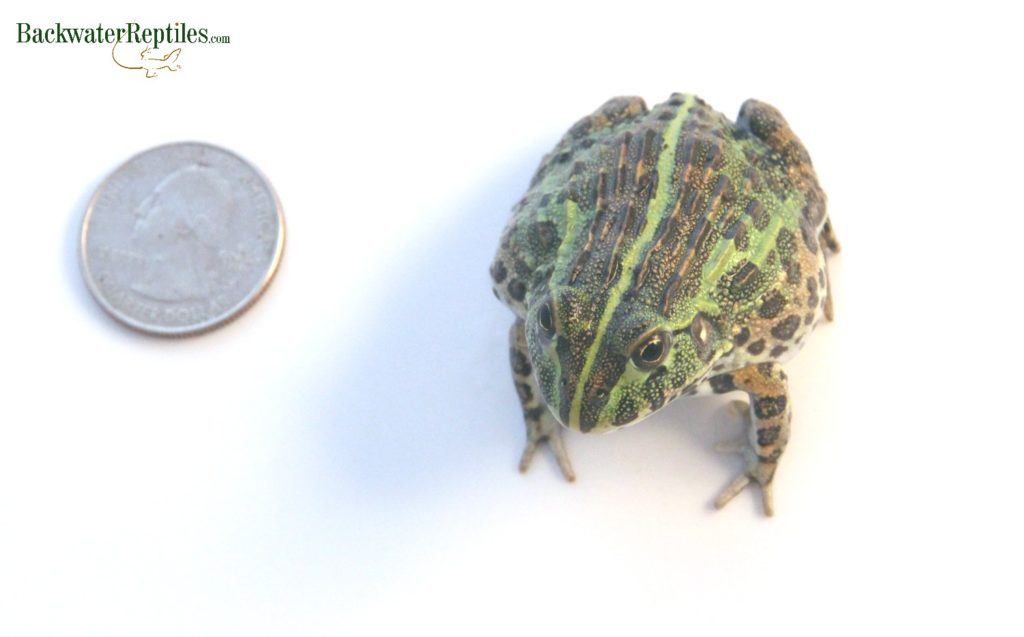
Although most pixies will simply burrow to hide themselves, we definitely recommend placing a hide space or two within your frog’s enclosure. Terra cotta pots, logs, and hides purchased from pet stores are all good options.
We use coconut husk fiber as substrate, at about two-inches deep. We keep the substrate damp throughout, but not dripping wet. If you notice the surface drying out, it’s a signal you’re not keeping the substrate damp enough.
If your frog senses a drier environment, it’ll cover itself in a type of cocoon layer to prevent moisture loss. This really shouldn’t happen in captivity. If you see it, make sure to make adjustments to prevent it from happening again.
Try to keep the tank in the temperature range of 74 to 82 degrees Fahrenheit. We keep them very successfully at room temperature.
Pixie Frog Feeding
If we haven’t already made it clear, pixie frogs love to eat! In the wild, they are ambush predators and will sit around until something comes their way that they can fit into their mouth. This means their prey items range from invertebrates to small birds!
Because they are not active animals, you will have to be careful not to overfeed your pixie frog. In fact, you’ll have to keep a close eye on your frog’s weight because pixies are prone to obesity.
We feed our pixies a staple diet of appropriately-sized insects, depending on the size of the frog. Our babies will eat mostly crickets, mealworms, and waxworms. Adults will eat crickets, hornworms, roaches, and wax worms.
Some people will feed their pixies pinkies or fuzzies, but we recommend this only as an occasional treat item. Again, pixies will eat to the point of being unhealthy, and fatty, high calorie items like mice will only contribute to the problem. Moderation is key.
Pixie Frog Disposition
As a general rule, most pet frogs don’t take well to human interaction or handling. We’ve found that with pixies, it tends to be a mixed bag. Some pixies don’t tend to mind being picked up, while others are quite opposed to the idea.
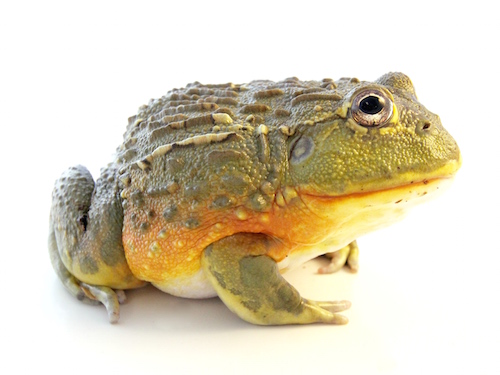
If you do want to handle your pixie on a regular basis, be sure it is supported fully. A flailing frog is not a happy frog. We also recommend washing your hands before and after picking up your pixie for the safety of both human and frog.
We’d also like to say that pixies have nasty bites. Be sure that when you pick up your frog that you keep wiggling fingers that could be mistaken for food away from its mouth.
However, I’ve picked-up hundreds of Pixie frogs spanning all sizes, and I’ve never had one attempt to bite or put on a threat posture.
These frogs rarely fight with each other, or have territory issues. If you keep more than one in an enclosure, just make sure you’re feeding them well. Don’t keep noticeably different sizes together because, as mentioned, they’ll eat anything they can fit into their mouths–including their own species.
Conclusion – Pixie frog care
Pixie frogs make excellent, fascinating, long-lived pets. They’re really fun to raise from babies to full-grown chubby adults. Feeding time is always entertaining when you have a pixie–a definite crowd-pleasing event!
If you’re interested in purchasing a pixie frog of your own, Backwater Reptiles sells both captive bred hatchlings and adults. You won’t be disappointed with this behemoth of a species!

